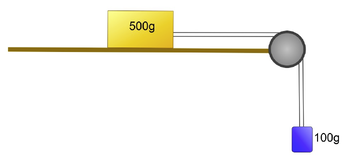Dynamics is a subset of mechanics, which is the study of motion. Whereas kinematics analysis the motion itself, Dynamics is concerned about the CAUSES of motion. In particular, it involves the concepts of force, momentum and energy. This video gives an overview of what dynamics is, and is useful as an intro to its study, or as a review.
|
One of the most important principles involving dynamics is the concept of force. It was Isaac Newton in the late 17th-century who, in his book Principia provided the analysis of what does, in what is now known as Newton's Three Laws or Laws of Motion.
The rest of this page examines those laws and examines also various situations involving forces. (although the concepts of momentum and energy are intricately related to force, we will leave the discussion on other pages.) |
1. Understanding Newton's Laws
video
pHET
problems
video
An overview of all three laws
|
|
Using the animation at pHET, I explain the three laws, starting at the 3rd, then the second and finally the first.
|
1st Law - a party trick
|
|
I produced this video in order to demonstrate newtons first law and in particular the concept of inertia.
You can perform this party trick yourself, but it's not magic it's physics! |
The Third Law
|
|
You can establish students understanding of newtons third law by giving them a well known scenario.
Newton's third law, often described as an action and reaction force, has often confused students. This video uses a horse and a cart to hopefully clarify understanding |
|
|
A summary of the three laws - useful for review
|
pHET
An opportunity to play with the pHET animation yourself. Click the three dots to go full screen
problems
- A bicyclist and his bicycle have a mass of 105 kg. What force is necessary to bring him to rest when he's travelling at 25 m/s and must stop to avoid a tree 4 m in front of him? (8200N)
- It takes a force of 109 N to lift a stone straight up. This also gives the stone and acceleration of 12 m/s/s. Calculate the mass of the stone. (5 kg)
- A car of mass 1000 kg accelerates uniformly and covers 100 m from rest in 10 seconds. The resistance forces are at a constant 200 N. What force is needed to accelerate the car? (2200 N)
- A person of mass 80 kg in a lift is standing on an accurate set of scales which reads 75 kg. Describe the motion of the lift.
2. The normal force, including inclines
video
worked solution
interactive
video
|
|
When an object rests on a surface, its weight is applying a force on the object, an according to Newton's 1st law . the surface is applying a force to that object to, resulting with a net force of zero. . This is referred to as the Normal force. But what if the surface is an incline, in other words, not perpendicular to the weight force?
This video examine the normal fore and tit relationship to the incline. |
worked solution
interactive
- Check out also this pHET interactive on Ramps, Forced and Motion.
At this stage this will only work on computers and not iPads
3. Friction
video
worked solution
interactive
problems
video
|
|
In this video we examine the principles of what friction is, the types of friction, and the mathematical models were use to calculate fictional forces.
|
worked solution
coming soon
interactive
This fairly straight forward interactive demonstrates a fundamental principle behind friction - it's not due to physics contact of the surfaces, but at an atomic level, due to the electroweak repulsive forces. It is the irregularity of the surfaces that lead to friction
problems
- A boulder of mass 45 kg is pushed on a surface with a coefficient of sliding friction of 0.85. What force has to be applied to produce an acceleration of 0.20 m/s/s (380N)
- A horizontal force of 30 N is required to slide a 12 kg wooden crate across the floor at a constant velocity, what is the coefficient of kinetic friction between the crate and the floor? (0.255)
- A sled is travelling at 4.00 m/s along a horizontal stretch of snow. The coefficient of kinetic friction is μk = 0.0500. How far does the slide go before stopping? (16.3m)
Want further practise? Here is another worksheet involving force and friction.
4. Forces in equilibrium
video
worked solution
problems
interactive
video
|
|
Using weights and pulleys, a situation can be in equilibrium, where there is no net force. This video looks at the situation and helps you mathematically analyse the situation |
worked solution
problems
- Examine the diagram below. Calculate the tensions in the ropes. (885 N, 1085 N)
Here is a worksheet on equilibrium situations (includes answers)
interactive
5. Pulleys not in equilibrium - Attwood's machine
video
worked solution
problems
video
|
|
What if masses hanging on pulleys are NOT in equilibrium? This video will examine accelerating systems and how to solve them. It also includes inclined examples |
worked solution
problems
|
1. Assuming the surface has negligible friction,
a. determine the acceleration of the system and the tension on the rope (1.63 m/s2, .82 N) b. If the surface in the above question has a μ = 0.1, what will be the new acceleration? (0.82 m/s2) c. The box sudden encounters a section of the surface that has a μ = 0.3. Explain what occurs. |
2. Determine the acceleration if μ = 0.15. (3.54 m/s/2)
6. How well do you know forces?
video
more problems
video
|
Test your understanding of Newton's Laws. So do the quiz and try to get full marks Then check your understanding if necessary with the video |
|
more problems
coming soon






